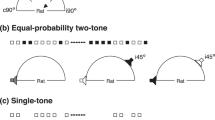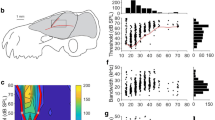Abstract
We examined factors that affect spatial receptive fields of single units in the central nucleus of the inferior colliculus of Eptesicus fuscus. Pure tones, frequency- or amplitude-modulated sounds, or noise bursts were presented in the free-field, and responses were recorded extracellularly. For 58 neurons that were tested over a 30 dB range of sound levels, 7 (12%) exhibited a change of less than 10° in the center point and medial border of their receptive field. For 28 neurons that were tested with more than one stimulus type, 5 (18%) exhibited a change of less than 10° in the center point and medial border of their receptive field.
The azimuthal response ranges of 19 neurons were measured in the presence of a continuous broadband noise presented from a second loudspeaker set at different fixed azimuthal positions. For 3 neurons driven by a contralateral stimulus only, the effect of the noise was simple masking. For 11 neurons driven by sound at either side, 8 were unaffected by the noise and 1 showed a simple masking effect. For the remaining 2, as well as for 5 neurons that were excited by contralateral sound and inhibited by ipsilateral sound, the peak of the azimuthal response range shifted toward the direction of the noise.
Similar content being viewed by others
Abbreviations
- E/E :
-
excitation at either ear
- I/E :
-
inhibition at the ipsilateral ear, excitation at the contralateral ear
- O/E :
-
no effect from the ipsilateral ear, excitation at the contralateral ear
- FM↓:
-
downward frequency modulation
- FM↑:
-
upward frequency modulation
- IC :
-
inferior colliculus
- ICC :
-
central nucleus of the inferior colliculus
- ILD :
-
interaural level difference
- ITD :
-
interaural time difference
- PT :
-
pure tone
- SAM :
-
sinusoidally amplitude modulated sounds
- SFM :
-
sinusoidally frequency modulated sounds
References
Aitkin L, Martin R (1990) Neurons in the inferior colliculus of cats sensitive to sound-source elevation. Hearing Res 50: 97–106
Casseday JH, Covey E (1992) Frequency tuning properties of neurons in the inferior colliculus of an FM bat. J Comp Neurol 319: 34–50
Casseday JH, Covey E (1996a) Mechanisms for analysis of auditory temporal patterns in the brainstem of echolocating bats. In: Covey E, Hawkins H, Port R (eds) Neural representation of temporal patterns. Plenum, New York pp 25–52
Casseday JH, Covey E (1996b) A neuroethological theory of the operation of the inferior colliculus. Brain Behav Evol (in press)
Casseday JH, Neff WD (1973) Localization of pure tones. J Acoust Soc Am 54: 365–372
Covey E, Casseday JH (1991) The monaural nuclei of the lateral lemniscus in an echolocating bat, Eptesicus fuscus. J Neurosci 6: 2926–2940
Covey E, Casseday JH (1995) The lower brainstem auditory pathways. In: Popper AN, Fay RR (eds) Hearing in bats. Springer, New York, pp 235–295
Covey E, Kauer JA, Casseday JH (1996) Whole-cell patsch-clamp recordings reveals subthreshold sound-evoked postsynaptic currents in the inferior colliculus of awake bats. J Neurosci 16 (in press)
Faingold CL, Boersma Anderson CA, Caspary DM (1991) Involvement of GABA in acoustically-evoked inhibition in inferior colliculus neurons. Hearing Res 52(1): 201–216
Feng AS, Vater M (1985) Functional organization of the cochlear nucleus of the rufous horseshoe bat (Rhinolophus rouxi): Frequencies and internal connections are arranged in slabs. J Comp Neurol 235: 529–553
Fuzessery ZM, Wenstrup JJ, Pollak GD (1985) A representation of horizontal sound location in the inferior colliculus of the mustache bat (Pteronotus p. parnellii). Hearing Res 20: 85–89
Irvine DRF (1992) Physiology of the auditory brainstem. In: Popper AN, Fay RR (eds) The mammalian auditory pathway: neurophysiology. Springer, New York, pp 153–231
Jen PH-S, Chen D (1988) Directionality of sound pressure transformation at the pinna of echolocating bats. Hearing Res 34: 101–118
Jen P H-S, Sun X, Chen D, Teng H (1987) Auditory space representation in the inferior colliculus of the FM bat, Eptesicusfuscus. Brain Res 419: 7–18
Kleiser A, Schuller G (1995) Response of collicular neurons to acoustic motion in the horseshoe bat, Rhinolophus rouxi. Naturwissenschaften 82: 337–340
Li L, Kelly JB (1992) Inhibitory influence of the dorsal nucleus of the lateral lemniscus on binaural responses in the rat's inferior colliculus. J Neurosci 12(11): 4530–4539
McFadden D, Pasanen EG (1974) High-frequency masking-level differences with narrow-band noise signals. J Acoust Soc Am 56: 1226–1230
Melssen WJ, Epping WJM (1992) Selectivity for temporal characteristics of sound and interaural time difference of auditory midbrain neurons in the grassfrog: A system theoretical approach. Hearing Res 60: 178–198
Moore DR, Hutchings ME, Addison PD, Semple MN, Aitkin LM (1984) Properties of spatial receptive fields in the central nucleus of the cat inferior colliculus. II. Stimulus intensity effects. Hearing Res 13: 175–188
Nelson PG, Erulkar SD (1963) Synaptic mechanisms of excitation and inhibition in the central auditory pathway. J Neurophysiol 26: 908–923
Neuweiler G (1989) Foraging ecology and audition in echolocating bats. Trends Ecol Evol 4(6): 160–166
Neuweiler G (1990) Auditory adaptations for prey capture in echolocating bats. Physiol Rev 70(3): 615–641
Obrist MK, Fenton MB, Eger JL, Schlegel PA (1993) What ears do for bats: a comparative study of pinna sound pressure transformation in Chiroptera. J Exp Biol 180: 119–152
Oliver DL, Huerta MF (1992) Inferior and superior colliculus. In: Webster DB, Popper AN, Fay RR (eds) The mammalian auditory pathway: neuroanatomy. Springer, New York, pp 153–231
Park TJ, Pollak GD (1993) GABA shapes sensitivity to interaural intensity disparities in the mustached bat's inferior colliculus: implications for encoding sound. J Neurosci 13(5): 2050–2067
Peff TC, Simmons JA (1972) Horizontal-angel resolution by echolocating bats. J Acoust Soc Am 51: 2063–2065
Semple MN, Aitkin LM, Calford MB, Pettigrew JD, Phillips DP (1983) Spatial receptive fields in the cat inferior colliculus. Hearing Res 10: 203–215
Simmons JA, Kick SA, Lawrence BD, Hale C, Bard C, Escudie B (1983) Acuity of horizontal angle discrimination by the echolocating bat, Eptesicus fuscus. J Comp Physiol 153: 321–330
Stokkum van IHM, Melssen WJ (1991) Measuring and modelling the response of auditory midbrain neurons in the grassfrog to temporally structured binaural stimuli. Hearing Res 52: 113–132
Takahashi TT, Keller CH (1994) Representation of multiple sound sources in the owl's auditory space map. J Neurosci 14(8): 4780–4793
Vater M, Habbicht H, Kössl M, Grothe B (1992) The functional role of GABA and glycine in the monaural and binaural processing in the inferior colliculus of horseshoe bats. J Comp Physiol A 171: 541–553
Vater N, Casseday JH, Covery E (1995) Convergence and divergence of ascending binaural and monaural pathways from the superior olive of the mustached bat. J Comp Neurol 351(4): 632–646
Wagner H, Takahashi T (1992) Influence of temporal cues on acoustic motion-direction sensitivity of auditory neurons in the owl. J Neurophysiol 68: 2063–2076
Wenstrup JJ, Ross LS, Pollak GD (1986) Binaural response organization within a frequency-band representation of the inferior colliculus: Implications for sound localization. J Neurosci 6: 962–973
Wenstrup JJ, Fuzessrey ZM, Pollak GD (1988a) Binaural neurons in the mustache bat's inferior colliculus. I. Responses of 60-kHz EI units to dichotic sound stimulation. J Neurophysiol 60: 1369–1383
Wenstrup JJ, Fuzessery ZM, Pollak GD (1988b) Binaural neurons in the mustache bat's inferior colliculus. II. Determinants of spatial responses among 60-kHz EI units. J Neurophysiol 60: 1384–1404
Yang L, Pollak GD (1994) The roles of GABAergic and glycinergic inhibition on binaural processing in the dorsal nucleus of the lateral lemniscus of the mustached bat. J Neurophysiol 71(6): 1999–2013
Yin TCT (1994) Physiological correlates of the precedence effect and summing location in the inferior colliculus of the cat. J Neurosci 14: 5140–5186
Yost WA, Sfeft S (1993) Auditory perception. In: Yost WA, Popper AN, Fay RR (eds) Human pychophysics: Springer handbook of auditory research, Vol. 3. Springer, New York, pp 193–236
Author information
Authors and Affiliations
Rights and permissions
About this article
Cite this article
Grothe, B., Covey, E. & Casseday, J.H. Spatial tuning of neurons in the inferior colliculus of the big brown bat: effects of sound level, stimulus type and multiple sound sources. J Comp Physiol A 179, 89–102 (1996). https://doi.org/10.1007/BF00193437
Accepted:
Issue Date:
DOI: https://doi.org/10.1007/BF00193437




